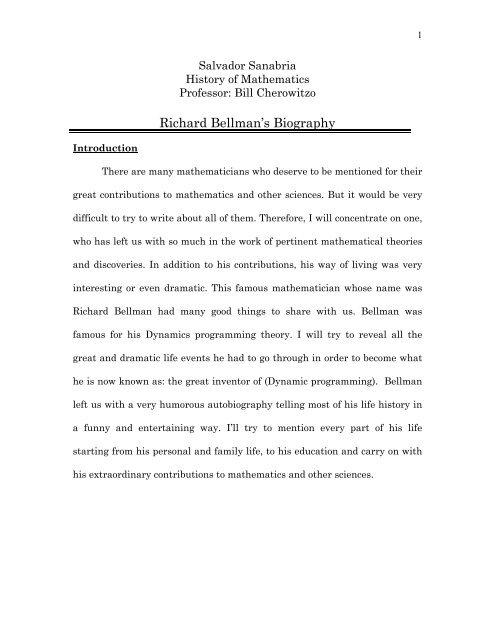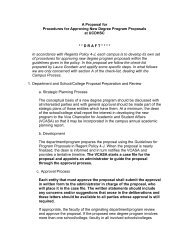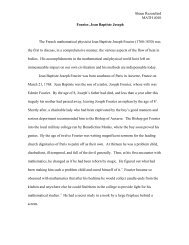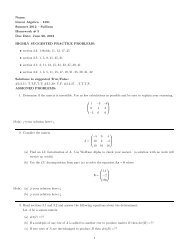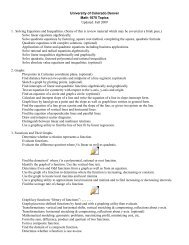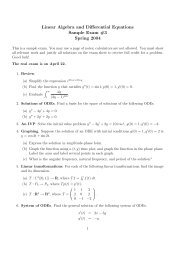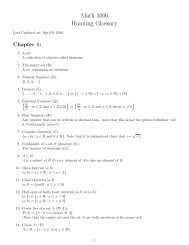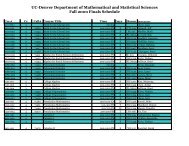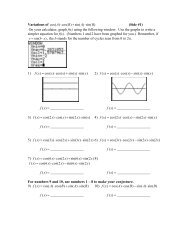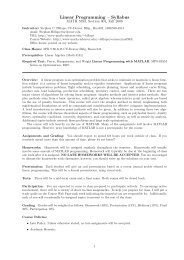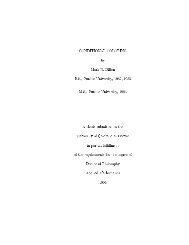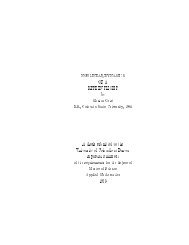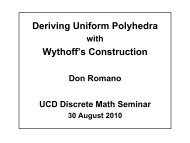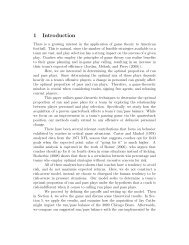Richard Bellman's Biography - Mathematical & Statistical Sciences
Richard Bellman's Biography - Mathematical & Statistical Sciences
Richard Bellman's Biography - Mathematical & Statistical Sciences
You also want an ePaper? Increase the reach of your titles
YUMPU automatically turns print PDFs into web optimized ePapers that Google loves.
Introduction<br />
Salvador Sanabria<br />
History of Mathematics<br />
Professor: Bill Cherowitzo<br />
<strong>Richard</strong> Bellman’s <strong>Biography</strong><br />
There are many mathematicians who deserve to be mentioned for their<br />
great contributions to mathematics and other sciences. But it would be very<br />
difficult to try to write about all of them. Therefore, I will concentrate on one,<br />
who has left us with so much in the work of pertinent mathematical theories<br />
and discoveries. In addition to his contributions, his way of living was very<br />
interesting or even dramatic. This famous mathematician whose name was<br />
<strong>Richard</strong> Bellman had many good things to share with us. Bellman was<br />
famous for his Dynamics programming theory. I will try to reveal all the<br />
great and dramatic life events he had to go through in order to become what<br />
he is now known as: the great inventor of (Dynamic programming). Bellman<br />
left us with a very humorous autobiography telling most of his life history in<br />
a funny and entertaining way. I’ll try to mention every part of his life<br />
starting from his personal and family life, to his education and carry on with<br />
his extraordinary contributions to mathematics and other sciences.<br />
1
Personal Life<br />
<strong>Richard</strong> Bellman was born in 1920, in New York City. His father John<br />
James Bellman was twenty and his mother, Pearl Saffian Bellman, was<br />
eighteen at the time he was born. His father used to run a small grocery<br />
store on Bergen Street near Prospect Park in Brooklyn. The last name of<br />
Bellman was originated in Sweden. Bellman says: “Bellman in Sweden is like<br />
Shakespeare in the United States.” This gives us an idea of how popular his<br />
last name was in Sweden.<br />
In Bellman’s account we find a nice detail about how his parents met.<br />
He acounts that his father John James met his soon wife to be, Pearl Saffian,<br />
at the beach and only knew her first name and that she worked in a big<br />
department store in Manhattan; he fell in love with her and continually stood<br />
outside every department store at 5.00 pm every day until he found her.<br />
Bellman talks a lot about his family including his aunts and uncles who show<br />
us how close he was to them.<br />
His father had four sisters: Pearl, Beth, Augusta and the last, Dorothy<br />
(who Bellman did not know much about). His mother had two siblings, Sylvia<br />
and Arthur. Bellman was the only son in his family but life was not that easy<br />
for him and his family as he repeatedly says "we were not suppose to be<br />
poor". He was referring to the fact that his father kept making wrong choices<br />
regarding his jobs. He took the Depression so seriously that he would decline<br />
2
most jobs offers that he had; and every time he was ready to make<br />
commitments it would be too late.<br />
Bellman confesses to us two curses he had to deal with during his<br />
childhood: bed-wetting and fear of the dark. As a young adult he talks about<br />
his experience with painful shyness. He had a fear of talking in front of class,<br />
which made him the last person to present on the last day of the term, while<br />
in high school. When he went to college, the fear was still there, but he forced<br />
himself to give as many talks as possible in order to overcome his shyness.<br />
Bellman’s philosophy was "Once I get started I will do well, and that many<br />
actors and actresses have the same problem".<br />
At 12 years of age Bellman, started to get interested in psychology,<br />
which he thinks may have helped him to deal with some of his problems he<br />
experienced during his adolescence. He was also fanatic about science fiction<br />
and literature such as the Harvard classics, among which his favorites were<br />
Mark Twain and Shakespeare. Mark Twain became the greatest influence for<br />
Bellman at this age by helping him to widen his imagination and to develop a<br />
great sense of humor. This was also the time when he started to realize that<br />
he had read enough fiction and decided to explore something real. At this<br />
point of his life for the first time, he starts getting into subjects like<br />
paleontology, archeology, philosophy, history, biography, etc. He starts<br />
reading science books by Paul de Kruif and the "Crucibles" by Jaffee. At the<br />
age of sixteen, he discovers a book on vector analysis, which caught his<br />
3
interest and starts reading it. The book was not easy to understand at this<br />
time, since he did not have great ability at geometry, but the fascination he<br />
felt for the subject gave him a good experience in geometry thus he managed<br />
to grasp the concepts.<br />
Education<br />
1937.<br />
Bellman completed high school at the Abraham Lincoln High School in<br />
In his junior year in high school he participated in the inter-scholastic<br />
algebra league that involved various high schools at the time. After finishing<br />
his high school he started his college career at City College of New York<br />
(CCNY). During this time CCNY was one of the most intellectual institutions<br />
of higher education in the US. This was right before the middle class<br />
migration out of the city, and a time for new opportunities in the elite<br />
institutions for the New Yorkers. CCNY had the choice of the best of New<br />
Yorkers with a serious intellectual bent. While he was at CCNY, he worked<br />
on becoming a theoretical physicist. But he decided to major in mathematics<br />
because for him this took a little work and he could continue learning<br />
theoretical theory. Finally he concluded that theoretical theory was not field<br />
he could do, thus he stayed with mathematics, which is how he became a<br />
mathematician. Some of his studies during college years included four terms<br />
of Greek drama and language, it was then when he discovered that he had<br />
4
good a memory since he was able to memorize most of the words. He did<br />
most of the mathematics by intuition and it was not until he started to write<br />
a book and teach that he felt like he needed to understand the whole theory.<br />
Bellman was also a member of the mathematics club also in college,<br />
where he occasionally heard talks about mathematics. The talk he<br />
remembered best was the talk by Courant about the problem of inscribing a<br />
triangle of minimum perimeter in a given triangle. He stayed in college for<br />
four and a half years and upon graduating from Brooklyn College he did not<br />
get any mathematics medal since he had already won it as a sophomore. He<br />
tells us that he preferred a book rather than a medal, which is how he started<br />
to collect some good books. One of the first books he bought was “Theory of<br />
Functions” and then “Fourier Integrals”. These books gave him such a good<br />
insight into mathematics that he even started to write some of his first<br />
papers at this time.<br />
Bellman had many friends while in college but there was only one<br />
person that got his attention, her name was Betty Jo. Betty and she was his<br />
first date. This was the time when he completed his college work and when<br />
he was trying to make plans for his career. They had decided to get married<br />
after completing their Ph. D; However, this did not happened since in the<br />
same year they graduated, in November 22 of 1941, they got married<br />
“because of the uncertainties of the world situation” he says. He was twenty-<br />
one and she was eighteen “we were both too young,” he said. During this<br />
5
time Bellman needed to find a way of obtaining a source of income when he<br />
found out about a job position of instructor in electronics, but he did not know<br />
much about it, so when he asked to be considered for the position, he was<br />
rejected due to the level of education he had. At this point he felt like his<br />
mathematics career was over. But in 1941, he moved to Belleville where he<br />
learned electronics. At Scott Field, he had the chance to get the rudiments of<br />
radio and electronics. This was something he started to enjoy since he could<br />
relate mathematics with the equations used by Van der Pol to describe the<br />
output of circuits. After spending six months in Belleville Bellman did not<br />
want to move back to New York so he and Betty decided to move to Madison,<br />
Wisconsin.<br />
While he was in Madison, Bellman was reading the “Duke<br />
<strong>Mathematical</strong> Journal or the Bulletin of the American <strong>Mathematical</strong> Society”<br />
where he found a paper on stability, which he struggled with to establish<br />
results since he only came up with inequalities, which did not mean much.<br />
While solving the problems in this journal, every time he got a solution the<br />
answers, although right, didn’t make sense to him. So he continued to solve<br />
the problems until he was convinced that the answers made sense to him.<br />
This was later to become the most significant part of his mathematical<br />
discoveries. These new ideas and discoveries started to get him to desire to be<br />
part of Princeton, which in his inner soul, he kept thinking to be<br />
unattainable. But it was not too long after that when he received a phone call<br />
6
from Lefshets, ASTP, Army Specialized Training Program, had just started<br />
and he was asked if he wanted to be an instructor in this program and come<br />
to Princeton.<br />
Bellman entered Princeton in 1943. This was an excitement for him,<br />
since for years he always wanted to go there. As a graduate student there,<br />
Bellman became a member of an inner circle of young mathematicians led by<br />
Professor Solomon Lefschetz. His doctoral research under Lefschetz resulted<br />
in his first major work "Stability Theory of Differential Equations" (1946),<br />
subsequently published on his first book in 1953, and regarded as a classic in<br />
its field. After he taught electronics in Princeton he then worked at a sonar<br />
lab in San Diego. He spent the last two years of the war in the army, but<br />
assigned to the Manhattan project at Los Alamos. He was a social creature<br />
and it was easy for him to meet many of the talented people working on the<br />
project secretly known as “the gadget”. Typically, the physicists considered a<br />
mathematician as simply a human calculator, ideally constructed to do<br />
numerical computations but not much more. Bellman was asked to<br />
numerically solve some Partial Differential Equations at work. His<br />
mathematical pride made him refuse this task. To the great surprise of the<br />
physicists, he actually managed to integrate some of the equations, obtaining<br />
closed form solutions. Holding true to tradition, they checked his solutions,<br />
not by verifying the derivation, but by trying some very special cases. It was<br />
clear he knew what he was doing. With this Bellman’s reputation as a very<br />
7
ight young mathematician was established at Los Alamos. During these<br />
years, he absorbed a great variety of scientific experiences. So much was<br />
being done due to the war demands. <strong>Richard</strong> Bellman is a towering figure<br />
among the contributors to modern control theory and systems analysis. His<br />
invention of dynamic programming marked the beginning of a new era in the<br />
analysis and optimization of large-scale systems and opened a way for the<br />
application of sophisticated computer-oriented techniques in a wide variety of<br />
problem-areas ranging from the design of guidance for space vehicles to pest<br />
control and network optimization. After staying on the faculty of the<br />
Mathematics Department at Princeton from 1946 to 1952, Bellman left to<br />
join the newly established Rand Corporation in Santa Monica, California. At<br />
Rand, he became interested in the theory of multistage decision processes,<br />
then emerging as an important problem-area in the control of both small- and<br />
large-scale systems. His invention of dynamic programming in 1953 was a<br />
major breakthrough in the theory of multistage decision processes - a<br />
breakthrough, which set the stage for the application of functional equation<br />
techniques in a wide spectrum of fields extending far beyond the problem<br />
areas, which provided the initial motivation for his ideas. In addition to his<br />
fundamental and far-ranging work on dynamic programming, Bellman has<br />
made a number of important contributions to both pure and applied<br />
mathematics. Particularly outstanding is his work on invariant imbedding,<br />
which by replacing two-point boundary problem with initial value problems<br />
8
makes the calculation of the solution more direct as well as much more<br />
efficient. His work on quasi-linearization and its applications to system<br />
identification has led to many results of a practical nature in the study of<br />
nonlinear systems. In the recent years, <strong>Bellman's</strong> research activity has<br />
focused increasingly on the application of mathematics to medicine and<br />
biological sciences. He is the founder of the journal "<strong>Mathematical</strong><br />
Biosciences," and the co-author of a forthcoming book "<strong>Mathematical</strong> Models<br />
in Medicine."<br />
Bellman spent the summer of 1948 at RAND, where an amazing array<br />
of talent was gathered, including David Blackwell, George Dantzig, Ted<br />
Harris, Sam Karlin, Lloyd Shapley, and many others, who provided the<br />
foundations of much of ‘decision and game theory’. The original intention was<br />
to do mathematics with some of the RAND talent on problems of prior<br />
interest. But Bellman turned out to be fascinated and partially seduced by<br />
the excitement in OR, and the developing role of mathematics in the social<br />
and biological sciences. Bellman’s mathematical abilities were widely<br />
recognized. He was a tenured Associate Professor at Stanford at 28, after<br />
being an Associate Professor at Princeton, where all indications were that he<br />
would have had an assured future had he remained there. He began to have<br />
doubts about the payoff for himself in number theory and returned to the<br />
atmosphere at RAND often, where he eventually settled and became fully<br />
9
involved in multistage decision processes, having been completely seduced,<br />
and much to our great benefit.<br />
Here is a non-mathematical item that should be of interest. To work at<br />
RAND one needed a security clearance, even though much of the work did not<br />
involve "security." Due to an anonymous tip, Bellman lost his clearance for a<br />
while: His brother-in-law, whom Bellman had not seen since he (his brother-<br />
in-law) was about 13, was rumored to be a communist! This was an example<br />
of a serious national problem that was fed, exploited, and made into a<br />
national paranoia by unscrupulous politicians.<br />
Bellman was a notable person, totally a man of his time and original in<br />
his interests, with a fantastic memory. Bellman was one of those who were<br />
the driving forces behind the great intellectual excitement of the times. The<br />
word programming was used by the military to mean scheduling. Dantzig's<br />
linear programming was an abbreviation of “programming with linear<br />
models”. Bellman has described the origin of the name “dynamic<br />
programming” as follows. An Assistant Secretary of the Air Force, who was<br />
believed to be strongly anti-mathematics was to visit RAND. So Bellman was<br />
concerned that his work on the mathematics of multi-stage decision process<br />
would be unappreciated. But “programming” was still OK, and the Air Force<br />
was concerned with rescheduling continuously due to uncertainties. Thus<br />
“dynamic programming” was chosen, a politically wise descriptor. On the<br />
other hand, when I asked him the same question, he replied that he was<br />
10
trying to upstage Dantzig's linear programming by adding dynamic. Perhaps<br />
both motivations were true [2].<br />
If one looks closely at scientific discoveries, ancient seeds often appear.<br />
Bellman did not quite invent dynamic programming, but many others<br />
contributed to its early development. It was used earlier in inventory control.<br />
Peter Dorato once showed him a (some what obscure) economics paper from<br />
the late thirties where something close to the principle of optimality was<br />
used. The calculus of variations had related ideas (e.g., the work of<br />
Caratheodory, the Hamilton-Jacobi equation). This led to conflicts with the<br />
calculus of variations community. But no one grasped its essence, isolated its<br />
essential features, and showed and promoted its full potential in control and<br />
operations research as well as in applications to the biological and social<br />
sciences, as did Bellman.<br />
Bellman published many influential works. It is sometimes claimed<br />
that many of his papers are repetitive and did not develop the ideas as far as<br />
they could have been. Despite this criticism, his works were poured over word<br />
for word, with every comment and detail mined for ideas, technique, and<br />
openings into new areas. He did a great amount of work. Evidently it was the<br />
work of someone with a great background in analysis as well as a simplistic<br />
mind and sharp eye for applications. In his work there are lots of examples,<br />
with broad coverage and usually simple simple assumptions. He had a clear<br />
writing style. His ideas flow very well through the problem formulations and<br />
11
analysis unlike many mathematics books that are hard to read and<br />
understand.<br />
Who was influenced by Bellman?<br />
According to Harold J. Kushner who worked with Bellman at the<br />
RAND Corporation Bellman was a great encouragement and influence to him<br />
in the field of Optimal and Stochastic control theory. He had received many<br />
awards in both fields. Also Mr. Kushner has written about 7 books and about<br />
160 papers, he has contributed to the fields of stochastic control theory and<br />
optimal control theory. He also mentions how Bellman used to tell him to<br />
write his first book and he finally did. This was the result Bellman’s<br />
encouragement.<br />
“There is one more indirect connection between us. Bellman was a<br />
student of Solomon Lefschetz at Princeton, head of the Math. Dept. at the<br />
time, a very tough minded mathematician and one of the powerhouses of<br />
American mathematics, and impressed with <strong>Bellman's</strong> ability. While at Los<br />
Alamos in WW2 Bellman worked out various results on stability of ODE's.<br />
Although he initially intended to do a thesis with someone else on a number<br />
theoretic problem, Lefschetz convinced him that those stability results were<br />
the quickest way to a thesis, which was in fact true. It took only several<br />
months and was the basis of his book on stability of ODE's. I was the director<br />
of the Lefschetz Center for Dynamical Systems at Brown University for many<br />
12
years, with Lefschetz our patron saint. Some of you might recall the book (not<br />
the movie) "A Beautiful Mind" about John Nash, a Nobel Laureate in Game<br />
Theory, which describes Lefschetz's key role in mathematics during Nash's<br />
time at Princeton,” Harold said.<br />
Bellman left the Rand Corporation in 1965 to join the faculty of the<br />
University of Southern California, where he holds a joint appointment as<br />
Professor of Mathematics, Electrical Engineering and Medicine. He lived in<br />
Santa Monica, wit his wife, Nina, who he spends much of his time on writing<br />
and the creation of new ideas. A prolific writer, he has authored over 620<br />
published research papers, and forty books and seven monographs.<br />
Bellman did a lot of traveling in America, Europe and Africa where he<br />
had done many talks and works. However, most of his recognition took place<br />
in The United States. <strong>Bellman's</strong> fundamental contributions to science and<br />
engineering had won him many honors. Famous among these are: First<br />
Norbert Wiener Prize in Applied Mathematics, awarded in 1970 jointly by the<br />
American <strong>Mathematical</strong> Society and the Society for Industrial and Applied<br />
Mathematics; First Dickson Prize, Carnegie-Mellon University, 1970; and<br />
John von Neumann Theory Award, awarded in 1976 jointly by the Institute<br />
of Management <strong>Sciences</strong> and the Operations Research Society of America.<br />
He was awarded the IEEE Medal of Honor in 1979, "For contributions to<br />
decision processes and control system theory, mainly the creation and<br />
application of dynamic programming." He was elected to Fellowship in the<br />
13
American Academy of Arts and <strong>Sciences</strong> in 1975, and to Membership in the<br />
National Academy of Engineering in 1977. But what is important to mention<br />
is that <strong>Richard</strong> Bellman won more than just fame, he won the admiration<br />
and affection of all who know him for his exceptional courage and greatness<br />
as a human being. There is still so much more that we owe to him since all<br />
the contributions he made have changed the way optimization is done by<br />
mathematicians. I was able to compile this biography by summarizing<br />
Bellman’s own book “Eye of the Hurricane: Auto <strong>Biography</strong>”.<br />
Some of the most important books written by <strong>Richard</strong> Bellman are:<br />
(2003) “Stability Theory of differential Equations”<br />
(2003) “Perturbation Techniques in Mathematics, Engineering and Physics”<br />
(2003) “Dynamic Programming”<br />
(1997) “Introduction to Matrix Analysis"<br />
(1995) “Modern Elementary Differential Equations”<br />
(1985) “Artificial Intelligence”<br />
(1984) “Eye of the Hurricane: An Autobiography”<br />
(1984) “Partial differential Equations”<br />
(1983) “Quasilinearization and he Identification Problem”<br />
(1983) “<strong>Mathematical</strong> Methods in Medicine”<br />
(1982) “<strong>Mathematical</strong> Aspects of Scheduling and Applications”<br />
(1972) “Dynamic Programming and Partial Differential Equations”<br />
(1970) “Algorithms, Graphs and computers”<br />
(1967) “Introduction to the Mathematic Theory of Control Process”<br />
14
(1962) “Applied Dynamic Programming”<br />
(1961) “Adaptive Control Process”<br />
(1961) “An Introduction to Inequalities”<br />
(1986) “Methods of Approximation”<br />
(1959) “Asymptotic Behavior of Solutions of Differential Equations”.<br />
15
Bibliography<br />
1. Bellman, <strong>Richard</strong>, (2003) “Dynamic Programming”, Dover Publications, Inc.<br />
2. Bellman, <strong>Richard</strong>, “Eye of the Hurricane and Autobiography,” World Scientific Publishing,<br />
1984.<br />
3. Bellman, Bellman, (1982) “<strong>Mathematical</strong> Aspects of Scheduling and Applications”<br />
4. Bellman, <strong>Richard</strong>, (1972) “Dynamic Programming and Partial Differential<br />
Equations,” Elsevier Science & Technology Books.<br />
5. Kushner, J. Harold at http://www.a2c2.org/awards/bellman/index.php<br />
16


